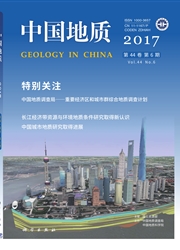

 中文摘要:
中文摘要:
柴北缘乌兰地区花岗岩锆石SHRIMP U-Pb定年结果表明,哈德森沟岩体的年龄为(413±3)Ma,许给沟岩体的年龄为(254±3)Ma,椅落山岩体的年龄为(251±1)Ma,察汗诺岩体角闪闪长岩和花岗岩的年龄分别为(249±1)Ma和(248±2)Ma,察汗河岩体年龄为(240±2)Ma,晒勒克郭来岩体的花岗闪长岩和花岗岩年龄分别为(250±1)Ma和(244±3)Ma。从年龄上看,这些花岗岩明显地分为两期:早期属早泥盆世(年龄为413Ma),形成的岩石组合为:石英二长岩+碱长花岗岩;晚期属晚二叠世-早三叠世(年龄为254-240Ma),又可进一步细分为254~251Ma、250~248Ma、244-240Ma三次侵位,对应的岩石组合为:闪长岩+花岗闪长岩+花岗岩。岩石地球化学研究表明,早期花岗岩类不仅富集大离子亲石元素,而且还富集部分高场强元素(Zr、Y、Nb等),属A型花岗岩;晚期花岗岩类富集大离子亲石元素,亏损高场强元素,属I型花岗岩。早期花岗岩的^87Sr/^86Sr比值(0.7108)和Nd模式年龄(T2DM=2.10Ga)均高于晚期花岗岩(0.7076-0.7107,T2DM=1.41~1.58Ga),但晚期花岗岩的eNd(t)值(-11.6)低于早期花岗岩(-4.8—-6.8),表明早期A型花岗岩可能起源于古元古代的大陆地壳,而晚期I型花岗岩起源于中元古代地壳。结合区域地质构造特征,我们认为,早期A型花岗岩的形成与祁连岩石圈拆沉导致欧龙布鲁克陆块北缘减薄、拉伸有关,也标志着宗雾隆裂陷的开始;而晚期I型花岗岩类的形成与宗雾隆洋壳向南俯冲于欧龙布鲁克陆块之下有关。
 英文摘要:
英文摘要:
Zircon SHRIMP U-Pb dating of granites in Wulan area of northern Qaidam indicates that Hadesengou rock mass was formed at (413±3) Ma, Xugeigou rock mass at (254±3) Ma, Yiluoshan rock mass at (251±1) Ma, hornblende diorite and granite of Cbahanruo rock mass at (249±1) Ma and (248±2) Ma, Chahanhe rock mass at (240±2) Ma, granodiorite and granite of Shailekeguo rock mass at (250±1) Ma and (244±3) Ma respectively. These granites have two formation periods: 1) the early period belongs to Early Devonian (413 Ma) with the rock association being adamellite+alkali-feldspar granite; 2) the late period belongs to Late Permian-Early Triassic (254-240 Ma) which can be further divided into three emplacements (254±251 Ma, 250-248 Ma and 244-240 Ma) with the rock association being diorite+granodiorite+granite. Geochemical study indicates that the early granitoids are not only enriched in large ion lithophile elements but also enriched in some high field-strength elements (Zr, Y, Nb etc.), thus belonging to A-type granite; the late granitoids are enriched in large ion lithophile elements and depleted in high field-strength elements, thus belonging to I-type granite. ^87Sr/^86S4 ratio (0.710 8) and Nd model age (T2nM=2.10 Ga) of the early granite are both higher than those of the late granite (0.707 6-0.710 7, T2DM=1.41-1.58 Ga). Nevertheless, eNd(t) of the late granite (-11.6) is lower than that of the early granite (-4.8 - -6.8). These data show that the early A-type granite might have originated from Paleoproterozoic continental crust, whereas the late I-type granite originated from Mesoproterozoic crust. Combined with regional geological structural characteristics, the authors consider that the formation of early A-type granite was related to the thinning and stretching of north Oulongbuluke block caused by Qilian lithosphere delamination which also marked the beginning of Zongwulong rift, while the formation of late I-type granite was
 同期刊论文项目
同期刊论文项目
 同项目期刊论文
同项目期刊论文
 期刊信息
期刊信息
